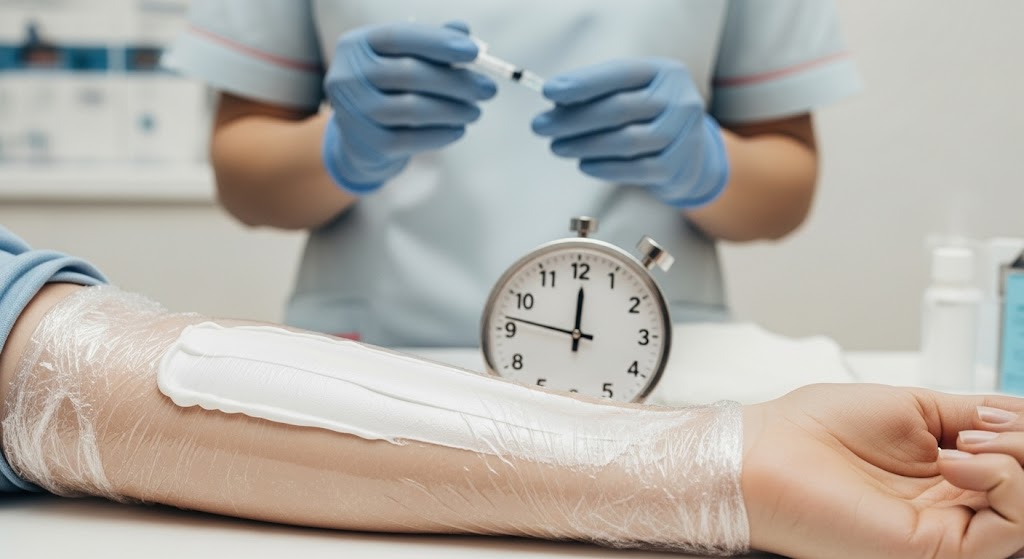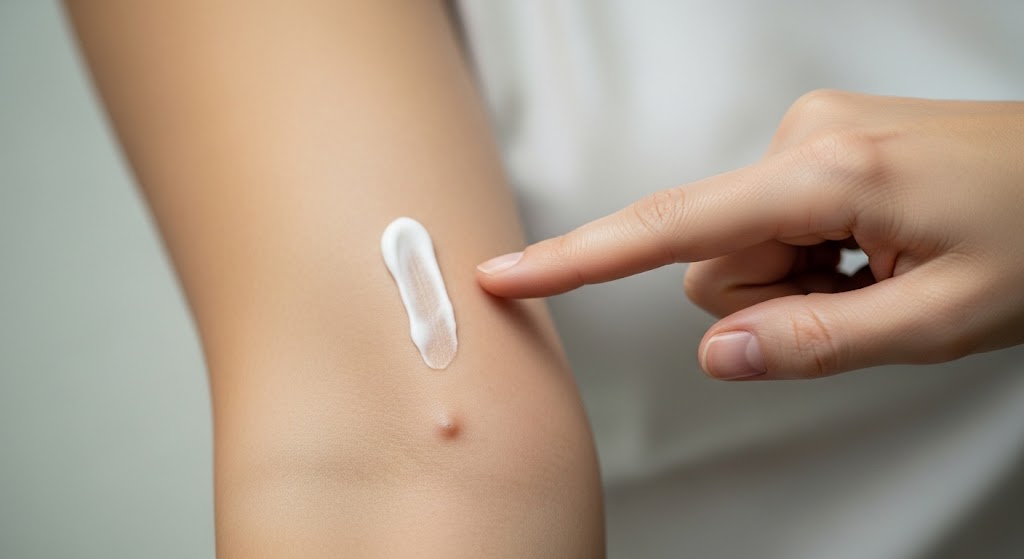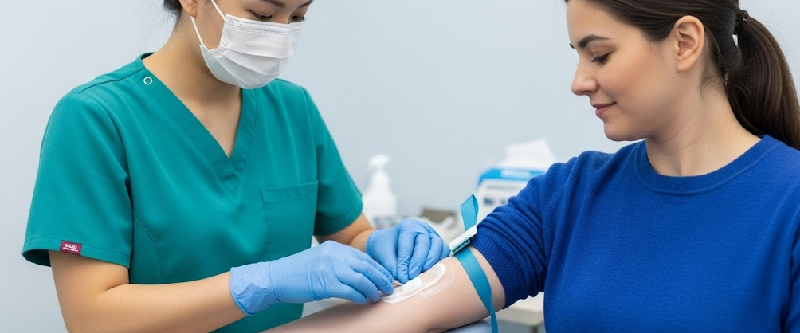If just hearing the words numbing, before, cream, blood, and draw makes you uneasy, you’re not alone. The thought of a needle going into your vein without any pain relief can be unsettling. What many don’t realize is that there’s a simple, effective way to make the experience easier and almost painless.
Using a numbing cream before a blood draw can greatly reduce discomfort and anxiety. It’s easy, accessible, and works well when applied correctly.
This article covers everything you need to know: how numbing creams work, when to use them, trusted products, and tips to make your next blood draw less stressful, for both adults and kids.
Numbing Cream Before a Blood Draw: 6 Benefits, 5 Risks

If you're considering using numbing cream before a blood draw, you're already one step ahead of most. But there's more to it than just slapping on a product and hoping for the best.
From picking the right cream to knowing when and how to apply it, the details make a huge difference.
This section breaks down exactly what you need to know—because when it comes to needles, getting it wrong isn’t worth the risk.
How Does Numbing Cream Work?
Numbing creams are topical anesthetics designed to dull sensation on the skin’s surface. Most contain lidocaine or prilocaine, which temporarily block nerve signals in the area where they’re applied.
These creams are widely used in medical and cosmetic settings, but their use before a blood draw isn’t as common as you’d think.
- Lidocaine-based creams usually take about 30–60 minutes to become fully effective.
- The numbing sensation typically lasts for about 1–2 hours, depending on your skin and the amount applied.
- Once absorbed, the area feels dull or mildly tingly, which helps reduce pain when the needle goes in.
This process doesn’t eliminate every feeling, but for most people, it significantly reduces the discomfort of a blood draw.
When Should You Apply the Numbing Cream Before a Blood Draw?
Timing is everything. Applying numbing cream before a blood draw too late—or even too early can make the effort pointless. To maximize the effect, follow this timing guidance:
- Apply 30 to 60 minutes before the scheduled blood draw.
- Cover the area with a non-stick bandage or plastic wrap to help the skin absorb the cream more effectively.
- Remove any residue right before the blood is drawn.
It's important to avoid applying it at the last minute. The numbing agent needs time to penetrate the skin’s surface. Some people think 10 minutes is enough, but it usually isn’t. If you’re heading to a lab, give yourself enough prep time at home so you’re not scrambling in the waiting room.
Where Exactly Do You Put the Numbing Cream?

For most blood draws, the needle is inserted into a vein inside the inner elbow, also known as the antecubital fossa. That’s your target area.
- Apply the cream directly over the vein area where the draw typically happens.
- If you’re not sure where that is, make a fist and look for the spot where the vein pops up most visibly inside your elbow.
- Avoid spreading the cream too wide, as that could dilute the effectiveness on the specific spot that matters.
In some cases, especially with kids or people with tricky veins, the technician may use a different site, but 9 out of 10 times, it’s the inner arm.
Are All Numbing Creams the Same? What Should You Look For?
No, not all numbing creams are created equal. Some are designed for tattooing, waxing, or minor skin procedures—but those aren’t always ideal for a blood draw.
When choosing a cream:
- Look for products with 4–5% lidocaine. This is a common and safe concentration for short procedures like bloodwork.
- Make sure it’s FDA-approved or at least well-reviewed by verified users.
- Avoid products with unnecessary additives or fragrances—they can irritate sensitive skin.
Popular over-the-counter brands like Emla, LMX4, or Aspercreme with lidocaine are often mentioned by patients and nurses alike. These are widely available and typically safe for occasional use before medical procedures.
What Are the Risks or Downsides of Using a Numbing Cream?
For most people, using numbing cream before a blood draw is safe, but not completely without risks. While serious reactions are rare, here’s what to keep in mind:
- Skin irritation or redness can occur, especially if the cream sits on your skin too long or isn’t wiped off properly.
- Some users report a burning or tingling sensation right after application, which usually fades.
- People with sensitive skin or known allergies to anesthetics should test a small patch before full use.
And while rare, overuse can lead to lidocaine toxicity, which is why it’s crucial to follow instructions and use only the recommended amount.
Should You Tell the Lab Technician You Used a Numbing Cream?

Yes, always. It’s not just a courtesy it can affect the outcome of the blood draw.
- Letting the technician know helps them avoid surprises, especially if the cream left residue or altered the feel of your skin.
- In some rare cases, numbing creams can constrict blood vessels, making it harder to find a vein.
Most professionals are perfectly fine with it and may even appreciate that you took proactive steps to make the process smoother.
Can Numbing Cream Help Reduce Needle Anxiety?
Absolutely. While the cream doesn’t erase fear, the psychological benefit of knowing you’ve done something to lessen the pain can be significant.
- It gives a sense of control, especially for people who have had traumatic experiences with needles.
- For children, using a numbing cream can be a game-changer, often reducing the need for restraint or emotional distress.
- Even adults with mild anxiety often report feeling more relaxed simply because they expect the draw to hurt less.
If fear of needles is affecting your willingness to get regular blood tests, this simple step could change your relationship with the process.
Can You Use Numbing Cream on Children Before a Blood Draw?
Yes, but with extra care. Pediatric use of numbing creams is fairly common, especially in hospitals and children’s clinics.
Important reminders for parents:
- Use only child-safe formulations, ideally recommended by a pediatrician.
- Never exceed the dosage or leave it on longer than instructed.
- Supervise the child during application to avoid accidental ingestion or rubbing it into the eyes or mouth.
Many pediatricians even apply numbing cream as standard protocol before needle procedures. Ask ahead to see if it’s available at your child’s clinic.
Conclusion:
If you find yourself tensing up every time a needle comes into view, you’re not alone—and there’s something simple that might help. Applying numbing cream before a blood draw isn’t just about easing pain; it can also help lower anxiety and make the whole experience feel less overwhelming.
When you use the cream at the right time and in the right way, you’re not just reducing discomfort—you’re giving yourself a bit of control in a situation that usually feels out of your hands. For people who’ve been putting off tests out of fear, this one small step might finally make those appointments more manageable.
FAQs
Yes, but it’s important to be cautious. If you have skin conditions like eczema, always check the ingredient list and do a patch test first. Some creams can irritate compromised skin or make flare-ups worse. Ask your doctor or pharmacist for a gentler option if you're unsure.
In most cases, yes—but moderation matters. Using a numbing cream now and then is generally considered safe, but if you're getting blood drawn regularly (like for chronic conditions), speak with your healthcare provider. Frequent application over the same skin area may increase the risk of irritation or decreased effectiveness.
No, they don’t interfere with test results, but they can make the draw a bit more challenging if applied improperly. Some creams may slightly constrict blood vessels, so always follow the instructions and let the technician know ahead of time.
Prescription creams can be stronger, but that doesn’t always mean better for a quick procedure like a blood draw. In many cases, an over-the-counter option with 4–5% lidocaine works just as well without the need for a doctor’s visit.
Technically, yes, but it’s not usually necessary. The discomfort from finger pricks is brief and much less intense than a full blood draw. Plus, the cream needs time to work—more time than most people want to spend on a quick test.
You can bring it, but most clinics prefer it’s already applied when you arrive. Since the cream takes time to work, applying it at the lab might delay your appointment. Plan and do it at home, about 30–60 minutes before your visit.


